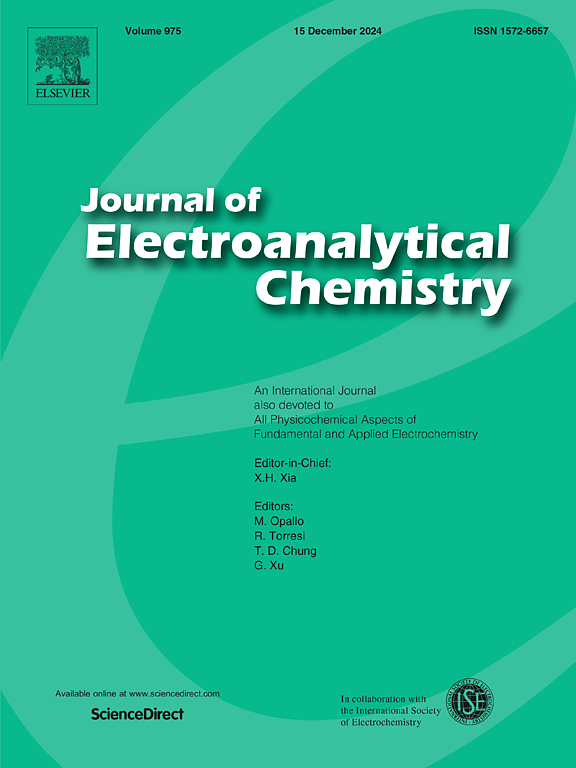Anionic doping strategy: F− to improve the conductivity and cell performances of SDC
IF 4.1
3区 化学
Q1 CHEMISTRY, ANALYTICAL
引用次数: 0
Abstract
The pollution and limitations of fossil energy are increasing year by year, and solid fuel cell is widely studied as a clean energy. Among electrolyte, SDC, as a common electrolyte material in fuel cell, still has some problems such as low electrical conductivity and electron conduction generated by Ce4+/Ce3+ in reducing atmosphere. In this article, the influence of F− doping on SDC and electrical conductivity in Ce0.8Sm0.2O1.95-δ-0.5xFx(CSOF)powder was investigated. A series of Ce0.8Sm0.2O1.95-δ-0.5xFx (x = 0.1, x = 0.03, x = 0.01) solid electrolyte powders were prepared by the glycine-nitrate self-propagating method. Through phase characterization of CSOF, When the F−doping reaches 0.03, the sample has the best conductivity, 55.91*10−3 S/cm at the temperature of 750 °C, and the conductive activation energy is 0.75 eV, which is suitable for the preparation of a single cell. In order to investigate the effect of conductivity on Ce-based materials in reducing atmosphere. Under H2 conditions, the conductive activation energy is 0.34 eV. At a temperature of 750 °C and the current density of 0.786 A/cm2, the power density is maximized at 0.366 W/cm2, and the maximum open-circuit voltage at 550 °C is 0.986 V. This demonstrates that F− doping is beneficial for enhancing the conductivity of the electrolyte.
阴离子掺杂策略:提高SDC的电导率和电池性能
随着化石能源的污染和局限性逐年增加,固体燃料电池作为一种清洁能源得到了广泛的研究。在电解质中,SDC作为燃料电池中常用的电解质材料,在还原性气氛中仍存在Ce4+/Ce3+产生的电导率低、电子传导等问题。本文研究了F−掺杂对Ce0.8Sm0.2O1.95-δ-0.5xFx(CSOF)粉末SDC和电导率的影响。采用甘氨酸-硝酸盐自扩散法制备了Ce0.8Sm0.2O1.95-δ-0.5xFx (x = 0.1, x = 0.03, x = 0.01)固体电解质粉末。通过对CSOF的相表征,当F−掺杂量达到0.03时,样品的电导率最佳,在750℃温度下达到55.91*10−3 S/cm,导电活化能为0.75 eV,适合单电池的制备。为了研究还原气氛中导电率对ce基材料的影响。H2条件下,导电活化能为0.34 eV。当温度为750℃,电流密度为0.786 a /cm2时,功率密度在0.366 W/cm2时达到最大,550℃时的最大开路电压为0.986 V。这表明掺杂F−有利于提高电解质的导电性。
本文章由计算机程序翻译,如有差异,请以英文原文为准。
求助全文
约1分钟内获得全文
求助全文
来源期刊
CiteScore
7.80
自引率
6.70%
发文量
912
审稿时长
2.4 months
期刊介绍:
The Journal of Electroanalytical Chemistry is the foremost international journal devoted to the interdisciplinary subject of electrochemistry in all its aspects, theoretical as well as applied.
Electrochemistry is a wide ranging area that is in a state of continuous evolution. Rather than compiling a long list of topics covered by the Journal, the editors would like to draw particular attention to the key issues of novelty, topicality and quality. Papers should present new and interesting electrochemical science in a way that is accessible to the reader. The presentation and discussion should be at a level that is consistent with the international status of the Journal. Reports describing the application of well-established techniques to problems that are essentially technical will not be accepted. Similarly, papers that report observations but fail to provide adequate interpretation will be rejected by the Editors. Papers dealing with technical electrochemistry should be submitted to other specialist journals unless the authors can show that their work provides substantially new insights into electrochemical processes.

 求助内容:
求助内容: 应助结果提醒方式:
应助结果提醒方式:


